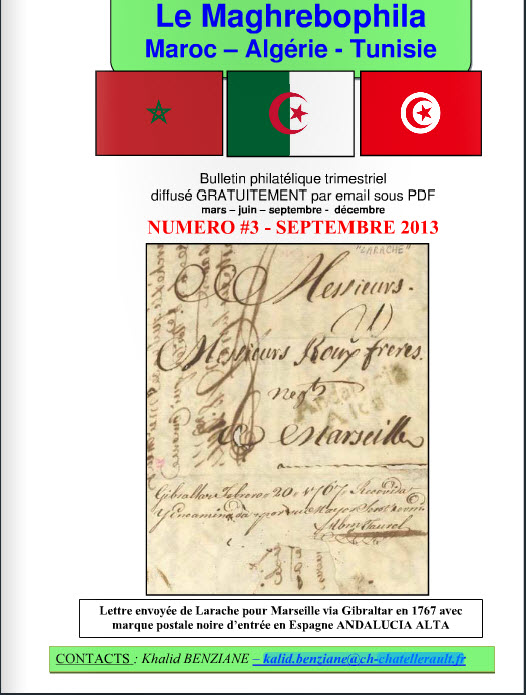
Extrait de l’éditorial:
Cher lecteur,
Comme vous le constatez ci contre, la diffusion du bulletin est mondiale et chaque semaine de nouveaux collectionneurs demandent à recevoir ce bulletin. Continuez donc à le
diffuser à vos amis.
N’hésitez surtout pas à nous envoyer des articles, des commentaires sur les articles parus ou des questions sur vos pièces.
Nous publions un incroyable listing d’ouvrages philatéliques sur la philatélie et l’histoire postale tunisienne. Nous devons ce fantastique travail à notre ami Johan Delbeke. Ce listing sera publié en trois parties.

Table des matières:
- Le Bureau espagnol de Casablanca, par Khalid Benziane (page 3-7)
- Escadrille américaine pendant la guerre du Rif, par Khalid Benziane (page 7-9)
- Des Russes à Bizerte, par Johan Delbeke (page 9-12)
- Philatelic bibliography of Tunisia (part 1), par Johan Delbeke (page 12-16)
The 1912 Treaty of Fez divided Morocco between France in the south and Spain in the north. In 1913 Spanish forces began to occupy and pacify the interior. In the eastern zone of the protectorate, Spanish troops set out from Melilla to occupy the area of the Rif. The ultimate goal was to reach Alhucemas Bay from the land side. Riffian tribesmen attacked the Spanish
forces and beseiged them at Annual. With no hope of rescue, the Spanish fled back toward Melilla, but most were easily slaughtered by the Riffians in the worst colonial military defeat for a European power in the twentieth century. The disaster led to the fall of the Spanish government and to General Miguel Primo de Rivera’s coup in 1923.
Spanish efforts to avenge this defeat and to suppress the Rif Rebellion (1921-27) began with a new strategy of falling back to defensive positions in the west and carrying out an amphibious landing at Alhucemas Bay, which would strike at the heart of Abd-el-Krim’s tribal homeland. Spanish planners sought to avoid the pitfalls that had doomed the Allies at Gallipoli during World War I. The September 1925 landings were not made within Alhucemas Bay, as the Riffians expected, but at nearby beaches. Using British-built landing craft, the invasion force was able to land, establish beachheads, and break out, defeating the Riffians within a few weeks of bloody, hand-to-hand fighting. It was the beginning of the end for the « Rif Republic ». The successful operation proved that with proper preparation (planning and reconnaissance) and overwhelming firepower/bombardment, an invading force could successfully disembark on a
hostile shore. Alhucemas bridged the gap between the disaster of Gallipoli and the success at Normandy. (Source: H-Net Discussion Networks)
The Journal of Military History, the quarterly journal of the Society for Military History, has published scholarly articles on the military history of all eras and geographical areas since 1937. The Journal is fully refereed. It publishes articles, book reviews, a list of recent articles dealing with military history published by other journals, an annual list of doctoral dissertations in military history, and an annual index. (Source: The Society for Military History)
About the author: José E. Alvarez


